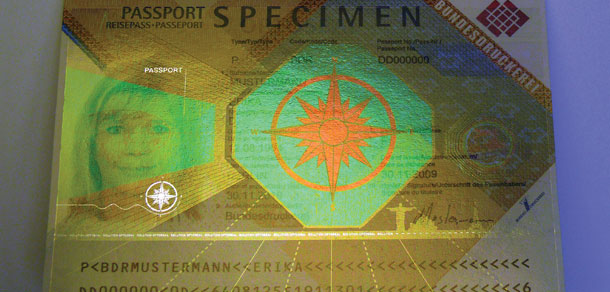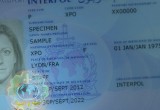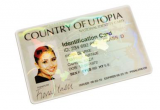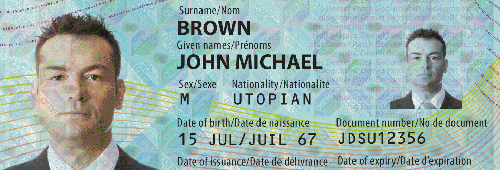New hologram tech protects high-value identity documents
14 January, 2014
category: Government
By Ian Lancaster, General Secretary, International Hologram Manufacturers Association
More than 65 years after its invention, the hologram remains a potent weapon in the battle against counterfeiters and organized criminal gangs in the multi-billion dollar trade of illicit passports, driver licenses and other fake ID documents.
The International Hologram Manufacturers Association (IHMA) works actively to ensure holography remains a relevant and added value solution today and well into the future, explains Ian Lancaster, IMHA general secretary.
Metallised holograms first appeared on ID documents in 1984 when the United Nations’ passports included the simple authentication devices on the book’s cover. Shortly thereafter, Brunei and Iraq incorporated a hologram inside the passport. In these early instances, the hologram served as an authentication device as opposed to protection for the personal data.
In the 1990s, this began to change when passports held by United Arab Emirates’ nationals incorporated the first all-over transparent hologram. In this instance, the hologram not only served as an authentication feature but also to protect the biographical data contained in the passport.
This new, all-over hologram required the development of new techniques for high refraction index coating of the hologram. This also marked a turning point as the number of passports issued with holograms as an authentication device and laminate to protect the biographical data page increased steadily. Today very few use a hologram as an authentication device only.
In 1999, the European Union drafted a set of security standards for passports that were codified in 2004 with EC Resolution No. 2252/2004. They mandated that an optically variable device (OVD) – the most common of which is the hologram – must be used for authentication and security on the biographical data page.
Another major driver for the inclusion of holographic technology on ID documents came in 2002 – in the wake of the Sept. 11, 2001 terrorist attacks – when the International Civil Aviation Organization (ICAO) specified that passports should feature optically variable devices like holograms to combat counterfeiters.
With the regulations from both the European Union and ICAO requiring an optically variable device, the technology has become a front line weapon in the fight against passport counterfeiters.
Today, it is estimated that 80 countries include holograms on their passports. A Keesing Reference Systems’ survey found that 55% of passports now use an optically variable device to protect the data.
The total production of passports is estimated at 150 to 300 million units per year. While this number is subject to annual fluctuation, it will undoubtedly rise as populations and the number of people travelling abroad increase. This, along with the fact that all ICAO member countries must now issue Machine Readable Passports with OVDs, all but guarantees a growing market for holograms.
Security shield
The principal role of a hologram on a passport or other identity document is to shield against forgery of the variable information such as the photograph and personal data. The ability to provide effective protection, however, lies in the continuous innovation, invention and evolution of holographic techniques.
Both optical effects and material science techniques have established holograms as authentication devices that are easily recognized yet difficult to accurately copy. They can be readily integrated into the production process and can stand up to the rigorous demands of a ten-year useful life.
Still virtually anything can be copied and thus the holographic industry continues to work vigorously to inform the public that even the most sophisticated holograms can be reproduced … to some extent.
The real debate is just how accurately can holograms be copied? The answer is not very accurately at all.
This is where the real value of holograms designed for security applications can be realized. The intrinsic features of holograms make them difficult to copy with 100% accuracy. This has ensured the hologram’s success. The document they protect may have been counterfeited and other overt features copied, but a poorly copied hologram will provide a tell tale sign that the credential is fraudulent.
Holograms serve not only as a deterrent and secure means of protection and authentication, but also as a warning that a document might be counterfeit. Therefore, a hologram’s purpose is not solely to prevent counterfeits but to act as an effective detection device, making it easy for the trained eye to distinguish the legitimate from the fake.
Next generation holograms meeting passport needs
Passport production and personalization is exacting and has proven to be technically challenging for the holographic industry. However, it is a challenge that manufacturers are responding to with promising developments including a whole new generation of personalized photopolymer holograms that match the bio data contained within the passport.
One example of this, HoloID from Hologram.Industries, enables high-speed in-line holographic personalization. Utilizing photosensitive material to create unique color patterns and animations, the technology provides control and colour modulation to create portraits and other features.
The information is recorded in the holographic laminate and the printed data on the substrate, providing a high primary level of security that is virtually impossible to falsify. At the secondary level, data in the electronic chip also matches with the holographic and printed information to provide an extremely high level of security and authentication.
Also making an impact in the battle for increased ID document security is Hologram.Industries’ DID visual security device. Visually quite different from traditional holograms, the solution creates a two-color diffractive image appearing at the direct reflection angle, which changes when the document is rotated 90 degrees.
The technology has already been adopted by 20 countries including China to meet the need for an easy to use but difficult to imitate security device. To date, there have been no reported attempts to counterfeit the technology or even imitate its color permutation effect.
Other holographic technologies are providing documents with visually appealing features coupled with added security. 3M’s transparent hologram security laminate shows a faint holographic image that exposes tampering and protects against the wear and tear of everyday use.
The Kurz KINEGRAM is being used to protect the contactless smart card chips now used on many passports. When the passport’s data page is tilted back and forth, the projected letters ‘OK’ are seen to move up and down with adjacent columns moving in opposite directions. Although the contour-based letters “OK” show strong contrast with respect to the background, these images cover very little surface area and therefore allow for sufficient see-through transparency to view the chip. Any attempts to physically tamper with the chip module would be immediately evident through the destruction of the KINEGRAM structures.
Future challenges
It’s clear that holography continues to demonstrate a strong ability to adapt and move with the times, remaining a highly effective and competitive counterfeiting deterrent. Holography not only safeguards the integrity of identity documents, but also adds real value by offering greater scope for design, functionality and ease-of-use.
The challenge remains, as ever, for manufacturers to respond to changing customer requirements and keep one step ahead of competing technologies through research, development and innovation. If the developments of the last few years are anything to go by, then the future for holography in ID document security remains assured.




